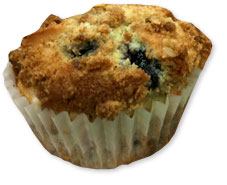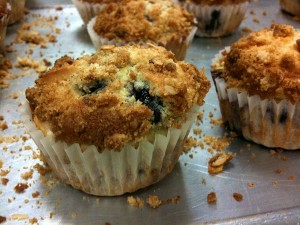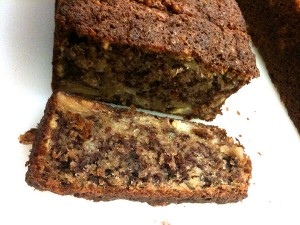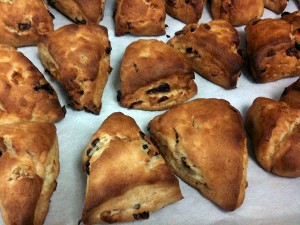
This week in baking class we covered quick breads. These baked goods use chemical leavening rather than yeast. Through the use of baking soda and or baking powder the baked item raises.
Baking Soda is pure sodium bicarbonate. When it interacts with moisture and the acid in the batter it produces bubbles of carbon dioxide that get larger with heat, causing quick bread to rise.
Baking powder includes sodium bicarbonate and acid. It’s available as single-acting or double-acting. Single-acting is activated by moisture – meaning you must bake it once you have mixed the batter. Double-acting reacts in two phases, some gas is released at room temperature when the powder is added to the mixture, however, the majority of the gas is released in the oven (heat) – so you don’t have to bake it right after mixing the dough.
If you use too much baking soda the result will be a soapy bitter taste.
We made four quick breads (banana bread, biscuits, muffins, and scones) and learned about three different blending methods.
- Creaming
Examples: cake batters, dense muffins
- Step 1: Mix fat and sugar in the mixer with a paddle until light in color, creamy and soft.
- Step 2: Adding Eggs one at a time (doing them all at once will cause clumping)
- Step 3: Add Flavoring (Vanilla, almond, lemon etc)
- Step 4: Add dry ingredients in 3 stages(if you have liquid add alternately starting and ending with dry ingredients)
- Step 5: Add garnishes (nuts, chips etc until just incorporated)
- Muffin (Blending)
Examples: crepes, pancakes, muffins
- Step 1: Combine all dry ingredients.
- Step 2: Combine all the wet ingredients.
- Step 3: Gradually add the dry ingredients to the wet ingredients.
- Biscuit
Examples: biscuits, scones, and pie crusts
- Step 1: Combine all dry ingredients.
- Step 2: Cut in the fat using your hands or a hand held tools (like a pastry cutter or two knives).
- Step 3: Add liquid mixing by hand.
- Step 3: Kneed dough.
- Step 3: Pat down or roll out and cut.
Heres what we made today:
 Blueberry Muffins
Blueberry Muffins Buttermilk Biscuits
Buttermilk Biscuits Banana Bread
Banana Bread Apricot and Cranberry Scones
Apricot and Cranberry Scones